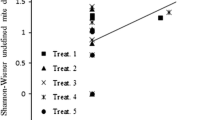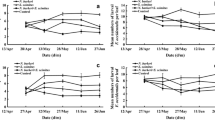Abstract
Seasonal changes in climate and plant diversity are known to affect the population dynamics of both pests and natural enemies within agroecosystems. In Brazil, spontaneous plants are usually tolerated in small-scale physic nut plantations over the year, which in turn may mediate interactions between pests and natural enemies within this agroecosystem. Here, we aimed to access the influence of seasonal variation of abiotic (temperature, relative humidity and rainfall) and biotic (diversity of spontaneous plants, overall richness and density of mites) factors on the communities of phytophagous and predatory mites found in a physic nut plantation and its associated spontaneous plants. Mite sampling was monthly conducted in dicotyledonous and monocotyledonous leaves of spontaneous plants as well as in physic nut shrubs over an entire year. In the dry season there was a higher abundance of phytophagous mites (Tenuipalpidae, Tarsonemidae and Tetranychidae) on spontaneous plants than on physic nut shrubs, while predatory mites (Phytoseiidae) showed the opposite pattern. The overall density of mites on spontaneous plants increased with relative humidity and diversity of spontaneous plants. Rainfall was the variable that most influenced the density of mites inhabiting physic nut shrubs. Agroecosystems comprising spontaneous plants associated with crops harbour a rich mite community including species of different trophic levels which potentially benefit natural pest control due to increased diversity and abundance of natural enemies.




Similar content being viewed by others
References
Addison JA, Hardman JM, Wilde SJ (2000) Pollen availability for predaceous mites on apple: spatial and temporal heterogeneity. Exp Appl Acarol 24:1–18. doi:10.1023/a:1006329819059
Altieri MA (1999) The ecological role of biodiversity in agroecosystems. Agric Ecosyst Environ 74:19–31. doi:10.1016/S0167-8809(99)00028-6
Andow DA (1991) Vegetational diversity and arthropod population response. Annu Rev Entomol 36:561–586. doi:10.1146/annurev.en.36.010191.003021
Arruda FP, Beltrão NEM, Andrade AP, Pereira WE, Severino LS (2004) Cultivo de pinhão-manso (Jatropha curcas L.) como alternativa para o semi-árido nordestino. Rev Bras Ol Fibros 8:789–799
Bellini MR, de Moraes GJ, Feres RJF (2005) Plantas de ocorrência espontânea como substratos alternativos para fitoseídeos (Acari, Phytoseiidae) em cultivos de seringueira Hevea brasiliensis uell. Arg. (Euphorbiaceae). Rev Bras Zool 22:35–42
Bianco S, Carvalho LB, Bianco MS (2008) Estimativa da área foliar de sida cordifolia e sida rhombifolia usando dimensões lineares do limbo foliar. Plant Daninha 26:807–813. doi:10.1590/S0100-83582008000400012
Brasil (1992) Ministério da Agricultura e Reforma Agrária. Departamento Nacional de Meteorologia. Normais climatológicas (1961-1990). MAPA, Brasília
Braun-Blanquet J, Bolòs O (1979) Fitosociología: bases para el estudio de las comunidades vegetales. H. Blume, Madrid
Cruz WP, Sarmento RA, Teodoro AV, Erasmo EAL, Pedro Neto M, Ignácio M, Ferreira DFF Jr (2012) Acarofauna em cultivo de pinhão-manso (Jatropha curcas L.) e plantas espontâneas associadas. Pesq Agropec Bras 47:319–327. doi:10.1590/S0100-204X2012000300002
Demite PR, Feres RJF (2005) Influência de Vegetação Vizinha na Distribuição de Ácaros em Seringal (Hevea brasiliensis Muell. Arg., Euphorbiaceae) em São José do Rio Preto, SP. Neotrop Entomol 34:829–836. doi:10.1590/S1519-566X2005000500016
Duso C, Malagnini V, Paganelli A, Aldegheri L, Bottini M, Otto S (2004) Pollen availability and abundance of predator phytoseiid mites on natural and secondary hedgerows. Biocontrol 49:397–415. doi:10.1023/B:BICO.0000034601.95956.89
Erasmo EAL, Pinheiro LLA, Costa NV (2004) Levantamento fitossociológico das comunidades de plantas infestantes e áreas de produção de arroz irrigado cultivado sob diferentes sistemas de manejo. Plant Daninha 22:195–201. doi:10.1590/S0100-83582004000200004
Fang WZ (1995) Natural resources of Guanfxi, China. China Environment Science Press, Beijing
Gardiner MM, Landis DA, Gratton C, Difonzo CD, O’neal M, Chacon JM, Wayo MT, Schmidt NP, Mueller EE, Heimpel GE (2009) Landscape diversity enhances biological control of an introduced crop pest in the north-central USA. Ecol Appl 19:143–154. doi:10.1890/07-1265.1
Gravena S, Coletti A, Yamamoto PT (1993) Influence of green cover with Ageratum conyzoides and Eupatorium pauciflorum on predatory and phytophagous mites in citrus. Bull IOBC-SROP 16:104–114
Gubitz GM, Mittelbach M, Trabi M (1999) Exploitation of the tropical oil seed plant Jatropha curcas L. Bioresour Technol 67:73–82. doi:10.1016/j.bbr.2011.03.031
Heikkinen RK, Luoto M, Virkkala R, Rainio K (2004) Effects of habitat cover, landscape structure and spatial variables on the abundance of birds in an agricultural-forest mosaic. J Appl Ecol 41:824–835. doi:10.1111/j.0021-8901.2004.00938.x
Heikkinen RK, Luoto M, Kuussaari M, Pöyry J (2005) New insights into butterfly–environment relationships using partitioning methods. Proc R Soc Biol Sci 272:2203–2210. doi:10.1098/rspb.2005.3212
Hernandes FA, Feres RJF (2006) Diversidade e sazonalidade de ácaros (Acari) em seringal (Hevea brasiliensis, Muell. Arg.) no Noroeste do estado de São Paulo. Neotrop Entomol 35:523–535. doi:10.1590/S1519-566X2006000400016
Instituto Nacional de Meteorologia (INMET). Monitoramento das Estações Automáticas, Gurupi e Palmas—TO, Data. 2010/2011. Available in: <http://www.inmet.gov.br/sonabra/maps/automaticas.php>. Accessed 18 July 2011
Issacs R, Tuell J, Fiedler A, Gardiner M, Landis DA (2009) Maximizing arthropod-mediated ecosystem services in agricultural landscapes: the role of natives plants. Front Ecol Environ 7:196–203. doi:10.1890/080035
Kreiter S, Tixier MS, Croft BA, Auger P, Barret D (2002) Plant and leaf characteristics influencing the predaceous mite Kampimodromus aberrans (Acari: Phytoseiidae) in habitats surrounding vineyards. Environ Entomol 31:648–660. doi:10.1603/0046-225X-31.4.648
Lemos F, Sarmento RA, Teodoro AV, Santos GR, Nascimento IR (2011) Agroecological strategies for arthropod pest management in Brazil. Recent Pat Food Nutr Agric 3:142–154. doi:10.2174/1876142911103020142
Letourneau DK, Armbrecht I, Rivera BS, Lerma JM, Carmona EJ, Daza MC, Escobar S, Galindo V, Gutiérrez C, López SD, Mejía JL, Rangel AMA, Rangel JH, Rivera L, Saavedra CA, Torres AM, Trujillo AR (2011) Does plant diversity benefit agroecosystems? A synthetic review. Ecol Appl 21:9–21
Lopes EN (2009) Bioecology of Polyphagotarsonemus latus in genotypes of physic nut (Jatropha curcas). MSc Thesis, Federal University of Viçosa.
Lucena RRM, Batista TMV, Dombroski JLD, Lopes WAR, Rodrigues GSO (2011) Medição de área foliar de aceroleira. Rev Caatinga 24:40–45
Marques RV, Sarmento RA, Ferreira VA, Venzon M, Lemos F, Pallini A. Search for suitable alternative food sources to predatory mites in a Jatropha curcas crop system. Neotrop Entomol (submitted)
Monteiro LB, Belli L, Souza A, Werner AL (2002) Efeito do manejo de plantas daninhas sobre Neoseiulus californicus (Acari: Phytoseiidae) em pomar de macieira. Rev Bras Frutic 24:680–682. doi:10.1590/S0100-29452006000300038
Openshaw K (2000) A review of Jatropha curcas: an oil plant of unfulfilled promise. Biomass Bioenergy 19:1–15. doi:10.1016/S0961-9534(00)00019-2
Palevsky E, Walzer A, Gal S, Schausberger P (2008) Evaluation of dry-adapted strains of the predatory mite Neoseiulus californicus for spider mite control on cucumber, strawberry and pepper. Exp Appl Acarol 45:15–27. doi:10.1007/s10493-008-9162-x
Pedro Neto M, Reis PR, Zacarias MS, Silva RA (2010) Influência do regime pluviométrico na distribuição de ácaros em cafeeiros conduzidos em sistemas orgânico e convencional. Coffee Sci 5:67–74
R Development Core Team (2006) R Foundation for Statistical Computing. Vienna, Austria. http://www.R-project.org
Rodrigues WC (2005) DivEs—Diversidade de espécies. Versão 2.0 Software e guia do usuário
Sarmento RA, Rodrigues DM, Faraji F, Erasmos EAL, Lemos F, Teodoro AV, Kikuchi WT, Santos GR, Pallini A (2011) Suitability of the Predadory mites Iphiseiodes zuluagai and Euseius concordis in Controlling Polyphagotarsonemus latus and Tetranychus bastosi on Jatropha curcas Plants in Brazil. Exp Appl Acarol 53:203–214. doi:10.1007/s10493-010-9396-2
Severino LS, Ferreira GB, Moraes CRA, Gondim TMS, Freire WSA, Castro DA, Cardoso GD, Beltrão NEM (2006) Crescimento e produtividade da mamoeira adubada com macronutrientes e micronutrientes. Pesqu Agropecu Bras 41:563–568. doi:10.1590/S0100-204X2006000400003
Severino LS, Vale LS, Beltrão NEM (2007) A simple method for measurement of Jatropha curcas leaf area. Rev Bras Ol Fibros 11:9–14
Shannon CE (1948) A mathematical theory of communication. Bell Syst Tech J 27:379–423
StatSoft (2004) Statistica for Windows: software system for data-analyses, version 8.0. Tulsa, StatSoft
Sudo M, Nishida S, Itioka T (2010) Seasonal fluctuations in foliar mite populations on Viburnum erosum Thunb. var. punctatum Franch. et Sav. (Adoxaceae) and sympatric shrubs in temperate secondary forests in western Japan. Appl Entomol Zool 45:405–415. doi:10.1303/aez.2010.405
Teodoro AV, Klein A-M, Tscharntke T (2008) Environmentally mediated coffee pest densities in relation to agroforestry management, using hierarchical partitioning analyses. Agric Ecosyst Environ 125:120–126. doi:10.1016/j.agee.2007.12.004
Tscharntke T, Rand TA, Bianchi FJJA (2005) The landscape context of trophic interactions: insect spillover across the crop-non crop interface. Ann Zool Fennici 42:421–432
Tsitsilas A, Hoffman AA, Weeks AR, Umina PA (2011) Impact of groundcover manipulations within windbreaks on mite pest and their natural enemies. Aust J Entomol 50:37–47. doi:10.1111/j.1440-6055.2010.00779.x
Van Rijn PCJ, Tanigoshi LK (1999) The contribution of extrafloral nectar to survival and reproduction of the predatory mite Iphiseius degenerans on Ricinus communis. Exp Appl Acarol 23:281–296. doi:10.1023/A:1006240126971
Zacarias MS, Moraes GJ (2002) Mite diversity (Arthropoda: Acari) on euphorbiaceous plants in three localities in the state of São Paulo. Biota Neotrop 2:1–12
Acknowledgments
The authors thank the National Council for Scientific and Technological Development (CNPq) for financial support (projects 620028/2008-4 and 475408/2008-0) and the Federal Agency for Support and Evaluation of Graduate Education (CAPES) for providing scholarship to the first author and scholarship from the National Postdoctoral Programme (CAPES-PNPD) to the fifth author. Wagner Ignácio and two anonymous reviewers provided helpful comments in a previous version of this manuscript.
Author information
Authors and Affiliations
Corresponding author
Electronic supplementary material
Below is the link to the electronic supplementary material.
Rights and permissions
About this article
Cite this article
Cruz, W.P., Sarmento, R.A., Teodoro, A.V. et al. Driving factors of the communities of phytophagous and predatory mites in a physic nut plantation and spontaneous plants associated. Exp Appl Acarol 60, 509–519 (2013). https://doi.org/10.1007/s10493-013-9663-0
Received:
Accepted:
Published:
Issue Date:
DOI: https://doi.org/10.1007/s10493-013-9663-0




